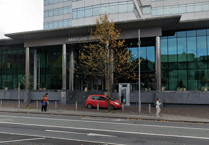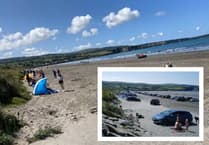Work on my house began in 1817 just two years after the Battle of Waterloo when Britannia really did rule the waves. It was built for the Master Shipwright under the design and direction of Edward Holl, a well known London architect for the Admiralty, who directed the fleet that patrolled Britannia's waves.
As might be expected for a man who would be responsible for building ships on a dozen slipways and employing hundreds of lesser shipwrights, the Admiralty ordered a spacious house with a walled garden and a coach house for his horses and carriage, paired with similar premises for the Clerk of the Cheque, whose title speaks for itself.
To classic Georgian design and detailing, the architect added some notable innovations. For the first time in Wales, roof trusses and purlins were of cast or wrought iron. Further fire-safety and soundproofing was achieved in the three intermediate floor levels with cast iron beams supporting both the traditional wooden floor above and the suspended ceiling below to take the added weight.
When I first saw the house, the RAF had left it 11 years before, but it made me feel happy! Even though my bank manager lost his gold rimmed glasses in the overgrown but naturally beautiful garden that was to become my wife's delight. The garden has several interesting trees, among them a gingko presented by the Japanese Ambassador in 1878 following Britain's first major transfer of technology to Japan when the Hiei, an iron, steam corvette, was completed in Pennar. It is said that her captain who, 25 years later, became Admiral Togo who sank the Russian Fleet in the Straits of Tsu Shima, resided in the house while his ship was built and learned much!
Jill and I have loved the house since 1967, nurturing it as well as our means permitted. Our children grew up there and now, 45 years on, my grandchildren drive me home there. Jill's garden, a place of memorable events, is ever a joy to my eyes. But my cosiness only repeats that of other families who have lived here over two centuries.
One of many enjoyable occasions occurred on June 5, 1854, the Master Shipwright Oliver Lang gave a luncheon at my house for Captain Sir Thomas Pasley Baronet, who had just handed over after five years as the Dockyard's naval Captain Superintendent. In those days, with the nearest railway station 40 miles away and no telephones, the Captain and the Master Shipwright were happily free from London direction day to day.
It was apparently a beautiful day and after lunch as they walked down to the waterfront for Sir Thomas's departure all of the dockyard staff lined the route to cheer him. When his boat left the steps, the cheering was taken up by the crews of HM ships Quail and Saturn. Finally, he arrived aboard the steamer Prospero and stood on the port paddle box to wave his farewell.
Afterwards he wrote: ".... and the last sound of Pembroke Dockyard that I shall ever hear died away. But the recollection will never die from my memory. I was quite overcome, and I felt it all deeply, for it was entirely spontaneous and I could not but be gratified... God bless them all!" These words say much about the people who built a prosperous Pembroke Dock with their own hands.
Fifteen years later, Admiral Sir Thomas Pasley KCB was to leave Portsmouth Dockyard where he had been Commander-in-Chief.
My House
2014 is a very important date in the history of Pembroke Dock as it is the year when residents of the town, as well as former residents who have moved all over the globe, will be celebrating the town's bicentenary. The town grew up to serve the needs of the flourishing Dockyard and it is unique in that it literally grew out of nothing as the Dockyard was built on what nowadays we would term a 'Green Field Site'.
In order to celebrate the way in which the town has expanded to accommodate all its residents, the organisers of the bicentenary celebrations are looking to hear from anyone who would like to write a short piece about their home and what they know about it. Maybe several generations of your family have lived in the same house for many years and you can write about how the house and the area have changed over that time; perhaps you were one of the first people to live in one of the new developments in Pembroke Dock after the Second World War or in one of the new houses on the Bush Camp or Pennar estates; perhaps your house has a particularly interesting history which you would like to share with readers or maybe you built your own home.
If you are interested in submitting an article to be featured in the future, then please contact [email protected]">[email protected] or 07811367840.




